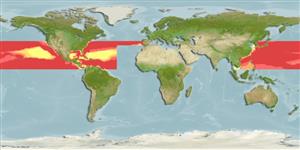Environment: milieu / climate zone / depth range / distribution range
Ecologia
marino; salmastro; oceanodromo (Ref. 51243); distribuzione batimetrica 0 - 1281 m (Ref. 58018). Subtropical; 41°N - 7°N
Atlantic Ocean: Canada (Ref. 5951) to New Jersey, USA to northern South America (Ref. 7251); reported from southern Africa. Also Indian and Pacific oceans.
Size / Peso / Age
Maturity: Lm ? range ? - ? cm
Max length : 30.0 cm SL maschio/sesso non determinato; (Ref. 48637)
Short description
Chiavi di identificazione | Morfologia | Morfometria
Spine dorsali (totale) : 10 - 12; Raggi dorsali molli (totale) : 22 - 24; Spine anali: 3; Raggi anali molli: 21 - 23; Vertebre: 34 - 38. Brown with darker brown vertical bands (Ref. 4412).
Epipelagic or mesopelagic in oceanic temperate waters. Rarely seen (Ref. 6891). Juveniles swim among tentacles of jellies (Ref. 48637).
Life cycle and mating behavior
Maturità | Riproduzione | Deposizione | Uova | Fecundity | Larve
Haedrich, R.L., 1986. Nomeidae. p. 846-850. In M.M. Smith and P.C. Heemstra (eds.) Smiths' sea fishes. Springer-Verlag, Berlin. (Ref. 4412)
IUCN Red List Status (Ref. 130435: Version 2024-2)
Threat to humans
Harmless
Human uses
Strumenti
Special reports
Download XML
Fonti Internet
Estimates based on models
Preferred temperature (Ref.
123201): 1.8 - 18.1, mean 11.5 °C (based on 404 cells).
Phylogenetic diversity index (Ref.
82804): PD
50 = 0.5313 [Uniqueness, from 0.5 = low to 2.0 = high].
Bayesian length-weight: a=0.01995 (0.00906 - 0.04395), b=3.01 (2.83 - 3.19), in cm total length, based on all LWR estimates for this body shape (Ref.
93245).
Trophic level (Ref.
69278): 3.6 ±0.5 se; based on size and trophs of closest relatives
Resilienza (Ref.
120179): Medio, tempo minimo di raddoppiamento della popolazione 1.4 - 4.4 anni (Assuming tm=2-4).
Fishing Vulnerability (Ref.
59153): Low to moderate vulnerability (27 of 100).
